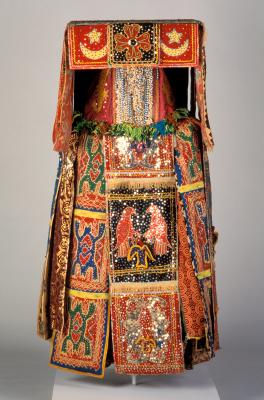1. Show students an image of the Egungun costume. Ask them to identify the following:
• the types of figures or decorations on the costume (animals, birds, moons, stars)
• the colors they see
• the shapes they see
• the materials that make up the costume (sequins, fabrics, yarn, shells, gold thread)
Explain to the students that the decoration on this costume tells a story about the things that were important to the people who wore the costume. The costume was handed down from family member to family member, and people kept adding decorations to it over time. Ask: What do you think was important to people from this culture? What do you notice? Why do you think this is important? How do you think it changed over time?
2. Have students share experiences they have had wearing costumes. Ask:
How does it feel to dress up or disguise yourself? How does it feel to dance?
Explain to the students that the costume was usually worn while dancing. Ask them to predict what it would look like with a moving person inside it. Have them predict:
What do you think this dance would look like? How would the dancer make the costume come alive? What do you think the music sounds like? (Have them demonstrate the dance, if they wish.)
Once students have made their predictions, show them the video of an Egungun costume being worn and danced. Discuss what the dance movements might represent.
3. Tell the students that they are going to make a costume that tells a story about themselves. The costume will have many panels, and each panel will represent a different characteristic about the wearer or show something that is important to the wearer. (Developing a model of a few panels about yourself will help.) Have students think about some of the things they would like to communicate about themselves. Have them choose their most important qualities or values. (The teacher can make a list for each student. with pictures and labels, or older children can brainstorm a list together as a class.) Then have the students select a visual image that will easily communicate that quality or value to others. For example, students who like stories may choose a book for one of their panels.
Younger students may fill their panels with the following:
favorite animal
favorite color
favorite shape
favorite number
favorite letter
4. Give students several sheets of 8 1/2 x 11" colored construction paper. Tell them that each sheet should represent one of their qualities or values. Students can use an assortment of materials to decorate their construction paper panels, including fabrics from home, sequins, glitter, markers, paints, crayons, yarn, and shells. When they have completed their panels, give each student one piece of poster board or foam core cut in half, one for the front of the costume and one for the back. Have students glue their construction paper panels to the poster board or foam core. Tie the pieces of poster board or foam core together with yarn like a sandwich board for each student, allowing enough space for the child to pass his or her head through the opening.
5. Ask for some volunteers to create a dance that relates to the imagery on their costumes. Have the volunteers put on their costumes and dance for the rest of the class. Ask the music teacher to find some appropriate music for this activity. While each student is dancing, ask the other students to describe what is important to the performers based on the decorative elements of their costumes. After the student finishes performing, have him or her respond to the comments, either validating or correcting the group's assessment.
As an extension, have the entire class present their costumes to the rest of the school in a parade format or a dance performance.
● Question students to determine understanding of shapes, colors, and animals, as well as how costumes can reflect customs and traditions.
● Assess the costume project, class discussion, and student participation to determine whether students have successfully communicated meaning through symbols.
● Assess the peer discussion to assess each student’s ability to communicate personal qualities and preferences through symbolic dance.
sequin
symbol
pattern
Construction paper, foam core or poster board, fabrics from home, sequins, glitter, markers, paints, crayons, yarn, shells
The Yoruba people believe that deceased individuals can intervene for good or ill in the lives of their living family members. It is essential, therefore, to honor ancestors, known as ara orun ("dwellers in heaven"), with elaborate rituals performed over a period of several weeks during the egungun ("powers concealed") ceremony held every one or two years in traditional Yoruba communities. Among the many types of costumes and masks worn during the festival, one of the most popular is a masquerade costume made up of multiple layers of cloth in many vibrant colors, textures, and patterns. The number of layers often reflects the age of a costume; each year, the family members who own it may add new layers of valuable cloth to honor their ancestor.
The tailor who fashioned this Egungun costume decorated its panels with motifs drawn from Yoruba, Islamic, and European traditions. The wearer of the costume would balance the wood panel (from which the many panels of cloth hang) on top of his head and peer out through the net face panel, which is adorned with cowrie shells, beads, and coins. While performing an acrobatic dance he would spin rapidly so that the fabric panels flew out, revealing the colorful layers of the costume in a spectacular display of color and pattern.


